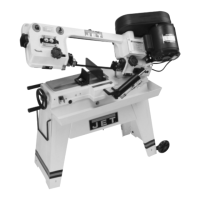16
2. Adjust the guide bearings according to
instructions in sect. 10.2, Adjusting guide
bearings.
3. Adjust the back-up bearing according to
instructions in sect. 10.5, Adjusting back-up
bearings.
4. With the arm in its full horizontal position and
the blade guides moved apart to clear the
widest possible cutting area, clip a scale to the
blade, to provide a vertical reference surface.
5. Place a machinist's square on the saw base,
against the scale. See Figure 20.
Figure 20: Adjusting the saw blade for vertical. Be
sure to do this operation on both of the bearing
guide seats so the blade is perfectly vertical along
its entire exposed cutting surface.
6. Loosen the guide bearing seat attachment bolt
slightly and, using a wrench on the bearing
seat, adjust the angle of the seat so the blade
is vertical. (There is a small amount of side
relief between the seat and guide bar to allow
for this adjustment.)
7. Tighten the seat attachment bolt.
8. Move the scale and square to the other side of
the exposed blade and repeat steps 4, 5, 6
and 7, above.
10.10 Test cutting to verify
adjustment accuracy
Test cuts can be used to determine whether or not
you have adjusted the blade accurately. Use 2
inch bar stock to perform these test cuts, as
follows:
1. With the bar stock securely clamped in the
vise, make a cut through the bar stock. (See
Figure 21.)
2. Mark the top of the bar stock.
3. Move the bar stock about 1/4 inch past the
blade so you can begin a second cut.
4. Rotate the bar stock 180 degrees so the mark
you made is now at the bottom of the cut.
5. Make a cut through the bar stock.
6. Use a micrometer to measure the thickness
variation between the top and bottom of the
disc you have cut from the bar stock. Unless
things are truly perfectly aligned, there is
almost certain to be a certain amount of
"wedge" to the shape of the disc you have cut.
The saw blade can be considered correctly
adjusted when the variation measured is no
more than .012 inch across the face of the
disc. If you do not have a 2 inch bar stock
available for a test cut, use a larger diameter
test work piece rather than a smaller one.
The maximum thickness variation on any
test piece should be no more than .003
inches, per side, per inch of stock diameter.
Figure 21: Making a test disc.

